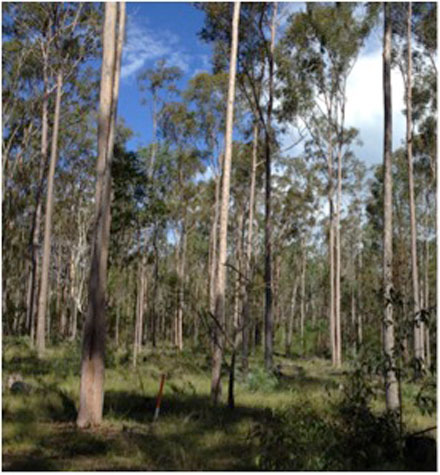
The New South Wales Codes of Practice and controls governing private native forest ignore long-term ecological sustainability, and are too complex and should be simplified, with the over-regulation sending a message of lack of trust, according to the state’s peak forestry body. The chief executive of Timber NSW, Maree McCaskill, said the existing private native forestry (PNF) Codes of Practice were not fit for purpose. Source: Philip Hopkins for Timberbiz
“They are unduly complex and unbalanced … and need to be made clearer and easier to read and use,” she said in Timber NSW’s submission to the government inquiry into private native forest regulations.
The complexity did not help private landowners who had limited experience in native forestry management and harvesting.
“Incorporation of active and adaptive management concepts would improve the Codes,” she said.
Ms McCaskill said many prescriptions in the Codes had no bearing on the long-term ecological health and productivity of the forest. Many important matters fundamental to long-term ecological sustainability remained non-binding guidelines.
“Silviculture, fire management and the control of pests and weeds are all major issues that receive minimal attention in the Codes,” she said. “However, the way these issues are managed – or unmanaged as the case may be – has a major bearing on the economic, social and environmental values that private native forests generate.”
Ms McCaskill said the Codes had too many ‘environmental protection’ prescriptions based on the ‘precautionary principle’ and were thus easy to measure and police. For example, 60% of the codes had prescriptions to protect listed species.
“This acts as a disincentive to survey the forest to find out what is there,” she said.
Ms McCaskill said PNF landholders should receive stewardship payments if they applied threatened species conservation prescriptions that affected their harvesting plans.
“The payments would provide an incentive for PNF landholders to survey their forests for threatened species and take a direct interest in their conservation,” she said.
Stewardship payments should cover the cost of identifying and managing threatened species as well as any economic loss.
“An economic loss occurs when forests which would otherwise be available are protected in an exclusion zone, and when additional recruitment trees (trees that would otherwise be harvested as sawlogs) are required to be retained,” she said.
Stewardship payments could also be offered to PNF landholders to control pests and weeds, while the Codes should also contain information on silvicultural best practice, including how to effectively regenerate moist forest types.
“For those with high-level experience, fire is a highly effective forest management tool that can assist the forest to regenerate after harvesting,” she said. The role of fire before and after harvesting should be considered in the Code.
Ms McCaskill said the Codes should provide incentives to implement best practice and not focus on a punitive process and regime. Instead they should focus on a long-term beneficial and lasting impact on the forests.
“The Codes should take a more holistic approach and try not to assess and determine the fate of every tree,” she said.
Ms McCaskill said to be efficient and effective, the regulatory settings should be kept simple and not be overly prescriptive, forcing ‘compliance’.
“In many ways, private native forestry is a form of large-scale permaculture that is built around natural processes. Assisting landholders and harvesting contractors to understand those processes is vital to achieving good forest outcomes,” she said. “Silvicultural best practice is typically the first casualty of over-regulation.”
Ms McCaskill said native forestry was not the primary business of most private landholders.
“The bush takes time to grow and can only be harvested for logs a few times over an individual’s working life. At harvest time, money can be made from PNF, but it’s not a lucrative business,” she said.
Over the long term, the ongoing costs of managing the bush used up the money made from timber sales.
“The regulatory settings need to take account of the costs that they impose. Having many restrictive rules costs money and if landholders don’t make money from selling timber, they have nothing to spend on caring for and regenerating the bush in the future.”
The current penalties, increased massively in 2018, were excessive and at odds with the risks of PNF, which the Government still effectively treated as a “clearing” activity.
Ms McCaskill said that when government over-regulated and overpoliced, “it sends a message of lack of trust”.
“This approach entrenches a negative attitude from the landholder and is ultimately counter-productive,” she said. “Good will is far more valuable when coupled with vital extension service, and longer term, will be a far more effective way of achieving compliance and good outcomes. Most landholders want to do the right thing; they just need the right advice and good guidance.”
Hence the need for effective Codes that set minimum standards and best practice.
Ms McCaskill said having to obtain two approvals – the Local Land Services Act 2013 (LSS) and the Environmental Planning and Assessment Act 1979 – was inefficient and a disincentive for involvement in forestry.
“The government should have a single ‘one-stop-shop’ approval system,” she said.
“The review of the PNF authorisation process also provides an opportunity for applicants to have their forest certified under PEFC or FSC.
“Automatic certification for anyone who applies and obtains an PNF plan would be ideal,” she said.
“However, if this is not possible then there should be provision for any additional requirements (to obtain the certification) to be incorporated into the LLS approval process.”
Ms McCaskill said the term of a PNF Plan should be greater than 15 years to encourage landholders to manage their forests for long-term sustainability.
“A rolling approval term of at least 20 years that is reviewed and extended every five years should be implemented, in a similar way the new Regional Forest Agreements operate,” she said.





